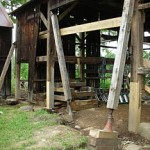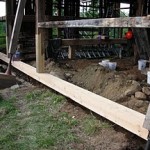Visiting the Hartland Historical Society in Vermont, historian Bill Hosley of Enfield, Ct., came upon a paper written in 1907 by a prominent local farmer, Byron P. Ruggles.
It was a hand-typed, 10-page manuscript with the less-than-compelling title “Modern vs. Conservative Dairying.” Hosley began reading.
One of the joys of poking around in the archives of a local historical society is that almost invariably you come upon something – letters, old photos, documents, something – that amounts to a revealing window into long-ago life. Sometimes that window gives us perspective; sometimes it helps explain how we got where we are, for better or worse.
The Ruggles paper, Hosley discovered, was one of those windows. He photocopied it.
In it, Ruggles , who was born in 1838 and died in 1917, was skeptical of the advice farmers were getting from academia, government and commerce.
Farmers were told: “We must use a seed drill, a land roller, a corn-planter, a corn-weeder, a cultivator, a corn harvester, a corn husker, a potato planter, potato hoer, potato digger, a reaper, mowing machine, hay tender, horse rake, horse pitchfork, ensilage cutter, threshing machine, drag and circular saws, and an engine to run some of the machines. We must have a silo. It would not do to think of stock or dairy farming without it.” He goes on for two pages complaining of what he was supposed to be buying, doing and not doing.
Most notably, though, Ruggles was bothered by the advice “to own and run large farms; that small farms are not profitable.” That of course became the government mantra of the 20th century, and led to the industrial farming dominant today. Industrial farming may be good at producing lots of food comparatively inexpensively, but it is fair to say, I think, that we are still sorting out the hidden and not-so-hidden environmental, nutritional and societal costs of the bigger-is-necessarily-better philosophy of farming.
Ruggles was one of those independent, civic-minded old New Englanders, the kind of guy, Hosley learned, who also founded the Hartland Nature Club and assembled its impressive natural history collections. He was an influential local leader in a small town along the Connecticut River that remains to this day a community of only 3,223 people. He also was a photographer. But first, he was a farmer. Bigger is better? After decades of farming, Ruggles figured he could shuck nonsense as easily as an ear of corn. He offered his own advice.
“Do not be a farmer unless you like the business and prefer it to another trade or occupation.”
“Do not buy a farm larger than you can do all the work on yourself.”
“Do not have a great multiplicity of farming tools. A plow, a harrow, a roller, a cultivator and a hoe are all the tools you need for working the soil.”
“Do not use any commercial fertilizers. You can raise good crops and increase the fertility of the soil without them.”
“Do not buy any meal or grain feed for your cows. Feed them with what you raise on the farm; that is what your farm is for. They must have good pasturage in summer; plenty of nutritious grasses… They must have good water to drink, such as you would drink yourself.”
“Do not keep cows in the barn all of the time in winter, nor most of the time. You cannot raise good calves from cows so kept. Let them out in the yard at least five or six hours a day except in stormy or very cold weather for sun and air and water and salt and exercise and general enjoyment.”
The Ruggles message was fundamental: respect the land, treat farm animals humanely.
It all sounds a lot like the kind of small, sustainable agriculture emerging in Connecticut and many parts of the country in recent years. I think, for example, of Megan Haney growing vegetables and flowers on three acres of land along the Housatonic River in Kent, Ct.
She starts and ends a long hot day in the field with a sunbonnet and a smile.
Oh, when she was starting out the representative of one federal agency told her that if her farm store wasn’t open every day she could fail. But her Marble Valley Farm store is open to the general public only two days a week in the growing season. After three years she has no plans to change; she is doing fine. Her Community Supported Agriculture program, in which families pay a farmer up-front for a season’s worth of vegetables provided weekly during the growing season, attracts more customers every year. Her farm store is a hit.
She uses a 60-year-old Allis Chalmers G tractor with 11- or 12-horsepower that looks, as she says, more like a Go-Kart than a serious farm tractor. It helps, for sure, but most work, all of the planting and much of the weeding is done by hand anyway. She farms organically. She does most of the work. She keeps it simple.
Her farm and her philosophy, it seems, are not unlike what Byron Ruggles was talking about all those years ago.
Reprinted with permission from the April 7, 2010 blog by Steve Grant, a freelance writer living in Farmington, Ct., www.thestevegrantwebsite.com.
 Hartland Village Cemetery, Hartland, VT, May 2013
Hartland Village Cemetery, Hartland, VT, May 2013



 When the project first began, the lowest post in the barn was more than fourteen inches below the highest post elevation. The highest post in the barn was resting on its stub tenon directly on the stone foundation. With the stub tenon being nearly three inches long and the sill timbers being nine inches in height, we determined that the post with the highest elevation was at least six inches low. Needing to clear the stub tenon when installing the new sills, we lifted the highest post to one inch above the height needed to clear the stub tenon with a nine-inch sill timber and stoned up to this finish height. This means that the lowest post was lifted a full two feet to the final resting height.
When the project first began, the lowest post in the barn was more than fourteen inches below the highest post elevation. The highest post in the barn was resting on its stub tenon directly on the stone foundation. With the stub tenon being nearly three inches long and the sill timbers being nine inches in height, we determined that the post with the highest elevation was at least six inches low. Needing to clear the stub tenon when installing the new sills, we lifted the highest post to one inch above the height needed to clear the stub tenon with a nine-inch sill timber and stoned up to this finish height. This means that the lowest post was lifted a full two feet to the final resting height.










 The other, in the stern, threw a rope which had an iron pick in the end of it, with an iron “dog” attached to it so that the “dog”, which was a piece of iron bent like a hook, could be driven down into the log with an axe. When the log was secured, it was guided under the boom by the man in the stern, while the rower started the boat down-stream, towing the log behind it. It was necessary to watch carefully lest the upper end of the log should be carried out into the current. When that happened, the man in the stern had only to knock out the “dog” and then the log was allowed to float down and go over the dam where it was caught and held in the eddy, Then it was drawn up to the mill by oxen.
The other, in the stern, threw a rope which had an iron pick in the end of it, with an iron “dog” attached to it so that the “dog”, which was a piece of iron bent like a hook, could be driven down into the log with an axe. When the log was secured, it was guided under the boom by the man in the stern, while the rower started the boat down-stream, towing the log behind it. It was necessary to watch carefully lest the upper end of the log should be carried out into the current. When that happened, the man in the stern had only to knock out the “dog” and then the log was allowed to float down and go over the dam where it was caught and held in the eddy, Then it was drawn up to the mill by oxen.
